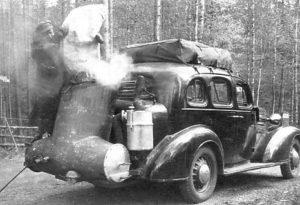Houtomobiles drove on wood gas. They were fairly well known here in WWII.
Driving on wood gas has not been a success
Driving on wood gas. This requires an entire installation. And because wood gas is low in calorificity, driving an h car saves around an 40 +% power compared to a gasoline engine. But brave attempts have been made. Usually from some sort of necessity. And the on-board electronics of a modern car would be completely upset.
According to Imbert, most Houto's drove using a wood gas gas factory
The Imbert wood gas generator is an invention of Georges Imbert. He developed the principle some 100 years ago. During the second world war, more than a million wood gasifiers were en route, almost all according to the Imbert principle. After the war, gas production soon started and people said goodbye to the wood gasifiers without regret. Knowledge and experience were almost immediately lost. From getting up early (warming up time) and getting dirty hands was also said goodbye without regret.
Well in Sweden
During the cold war, the Swedes continued to develop the system. But apart from the publication of research documentation, little has been done with it. After all, the approach was that it would only be necessary during a crisis to be able to rely on fuel from its own source, on wood gasification, because Sweden has virtually no fossil fuels. But they have plenty of wood in Sweden. All those trees are just waiting for them to make themselves useful.
The energy crises in the 1970s also led to a small revival in the interest in wood gasifiers for combustion engines, which subsided just as quickly when economic conditions improved.
And with the Finns
Only with the Finns has the mobile wood gasifier never completely disappeared. Not in large-scale, government-subsidized projects, but because of the enthusiasm of a small group of people. They have further refined the further development of the Swedes. With that, the development of wood gasifiers remains something from the world of idealists, technicians and environmental dreamers. Because driving on wood gas: You still don't do that for pleasure.
The principle
The "gasfier unit" is filled with wooden blocks. The nozzles dose the air. The motor vacuum ensures "pull" throughout the system. Indirectly the engine speed and engine load regulate the amount of gas produced and thus the air supplied. With a typical generator, the gas is taken high to give ash particles time to stay behind and to heat up the wood supply.
From there, the gas passes through a cooler to drain and reduce the volume. Think "Intecooler." The energy content increases due to the volume reduction and removal of water vapor. After the filter train, the gas can go to the engine via a simple gas / air mixer. A fan is needed to generate artificial draft before the start of the gasification process.
More modern Imbert units work differently.
The generator has a condensing jacket around the bunker, to further pre-dry the wood supply and to remove excess water. A cyclone removes the coarse ash particles. A fiberglass cloth filter removes the rest of the iniquities. The cooler also dehydrates the gas here. During the start-up, the blower blows the gas out even before the filter train, to prevent the filter from clogging up tar and water vapor from the still cold oxidation zone.
Compared to the original Imbert, some things have changed outside of the principle. Much attention has been paid to preheating the primary air to further increase the oxidation temperature. This in turn causes problems, because not all materials can withstand this temperature. All in all, the matter has become quite a bit more complex than it used to be, but the result, the gas has become 'cleaner'.
While maintaining the aforementioned disadvantages. And you can also write the Airmiles on your stomach.









